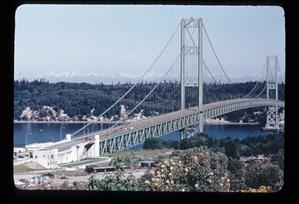On October 14, 1950, the second Tacoma Narrows Bridge opens to traffic. The bridge carries State Route 16 across the Tacoma Narrows, a windy and treacherous part of Puget Sound. It replaces the first Tacoma Narrows Bridge, which collapsed on November 7, 1940. The opening is a momentous event not only for Tacoma but also for the worldwide engineering community. The structure is the first suspension bridge built in the United States since the failure of its predecessor, and the design incorporates engineering knowledge gained from that catastrophe. With this bridge, aerodynamic testing becomes standard procedure in building suspension bridges. The bridge connects Tacoma to the Kitsap Peninsula, a link vital to the economy of Tacoma.
Learning From Past Errors
Years of study followed the collapse of the first Tacoma Narrows Bridge, which became a textbook case of problems to avoid in building suspension bridges. The research was already in progress when the first bridge collapsed, since the structure's habit of undulating on windy days (causing it to be affectionately termed "Galloping Gertie") worried engineers. The Washington Toll Bridge Authority, which owned the bridge, had engaged the University of Washington Engineering Department to study the structure. UW Professor Frederick B. Farquharson led the team and he was on the ground taking measurements on the day the bridge collapsed. The bridge failed because it was too light, with a too-narrow a roadway, and because of solid girders and the solid deck that caught the wind like a kite instead of letting it pass through.
The second Tacoma Narrows Bridge, built from 1948 to 1951, has perforated girders and open grating in the deck that lets the wind pass through. Also, a larger width-to-span roadway proportion (the wider roadway) works against any tendency to twist. The Design Engineer of the new bridge was Dexter R. Smith and the Principal Engineer was Charles E. Andrew. They collaborated on the design with Farquharson's research group at the University of Washington. The team did elaborate tests on a model bridge using a wind tunnel. The work of Theodore von Karman in wind tunnel analysis at the California Institute of Technology was also of vital importance.
Building the Bridge
The building began in April 1948. Bethlehem Pacific Coast Steel fabricated and erected the steel truss part of the bridge. John A. Roebling's Sons spun the cable. The bridge cost $11 million and was financed by a $14 million bond issue. The Washington Toll Bridge Authority operated the bridge until the bonds were paid off. In 1965 the Washington Department of Highways, later renamed Washington State Department of Transportation (WSDOT), took over ownership. The bridge has passed every test and remains a steady, solid, reliable structure.
Traffic was heavy on the bridge almost immediately. By 1967 traffic built up to 67,000 vehicles per day, which by 2004 had increased to some 90,000 vehicles per day. In 2003 WSDOT began construction on a third Tacoma Narrows Bridge, parallel to and south of the existing bridge.
The new Tacoma Narrows Bridge is a twin bridge and has a separated bicycle and pedestrian walkway. It was dedicated on July 15, 2007.

